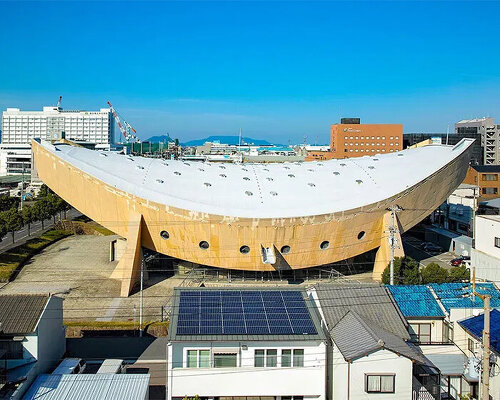Kagawa Prefectural Gymnasium’s demolition news
News surrounding the potential demolition of the concrete and modernist Kagawa Prefectural Gymnasium by Pritzker Prize-winning architect Kenzo Tange (1913–2005) in Japan has spurred an ongoing movement to save the beloved landmark, home to local sports events in Takamatsu for over 50 years. While demolition was scheduled for 2025, a major update emerged on July 2025, when the prefectural government announced a formal acquisition and preservation plan, including a private proposal to fully renovate and repurpose the building as a hotel and cultural hub — a self-funded alternative that could spare the icon from demolition.
view of the Kagawa Prefectural Gymnasium from the northwest, 2016
Shut down in 2014 due to lack of maintenance
The Kagawa Prefectural Gymnasium by Kenzo Tange was closed on September 30, 2014, due to the need for seismic retrofitting and a roof leak caused by rusting suspension cables, which had to be replaced for the building to remain in use.
For years, no prospective bidders stepped forward to salvage the historical landmark, and the team behind the World Monument Funds feared that the situation might increase the likelihood of demolition. In June 2018, the gymnasium was included among eight global sites to receive preservation funding from American Express through the World Monuments Fund program.
bird’s-eye view from the south, 2016 | photo by Noriyuki Kawanishi
Kenzo Tange reinforced concrete for his vessel building
In the 1950s, Masanori Kaneko, then governor of Japan’s Kagawa Prefecture, tapped Kenzo Tange to design two new buildings in the prefectural capital, Takamatsu. At the time, Tange was Japan’s leading architect, also working on the design of the Yoyogi National Gymnasium for the 1964 Tokyo Olympics.
For the Kagawa Prefectural Gymnasium, the architect used modern materials to evoke the form of a traditional Japanese wooden barge as well as the strong, supple body of an athlete. The tilted-ship shape of the structure, the root of its moniker ‘boat gym,’ consists of a deep concrete ring carried on four massive supports, with a roof of thin concrete slabs supported by suspension cables. Inside, the sports hall lies above the entry level, which contains other facilities including dressing rooms and offices. Built in the 1960s, the gymnasium was Tange’s way of exploring how reinforced concrete could create a vast, dynamic interior space.
The eaves soar upward above the welcoming glass facade of the entrance, while the symmetric curved ceiling evokes excitement during competitions and ceremonies. The World Monuments Fund has warned that destroying this invaluable gymnasium would be ‘an irretrievable loss.’
image courtesy of Kagawa Prefectural Gymnasium
A NEW FUTURE FOR THE ‘BOAT GYM’
Due to this support, the WMF launched a project in 2019 to foster community initiatives against demolition. However, until recently, without a solid buyer to restore and maintain the structure, the prospect of bulldozing the building remained on the table. Now, the self-funded private proposal signals a turning point: if approved, the plan would not only preserve one of Kenzo Tange’s modernist masterpieces but also transform it into a vibrant destination for art, culture, and tourism — offering a sustainable alternative to demolition and ensuring the legacy of the ‘boat gym’ for future generations.
west view of the Kagawa Prefectural Gymnasium, 2017 | photo by Yuichi Hirano
images courtesy of World Monuments Fund | header and photo by Noriyuki Kawanishi
east side cantilever, 2017 | photo by Yuichi Hirano
entrance foyer, 2016 | photo by Hidehiko Waki
third floor arena, 2014 | photo by Noriyuki Kawanishi
south side night view, 2009 | photo by Noriyuki Kawanishi
east side night view, 2009 | photo by Noriyuki Kawanishi
project info:
name: Kagawa Prefectural Gymnasium
architect: Kenzo Tange (1913 – 2005)
petition: here by World Monuments Fund
The post saving kenzo tange’s kagawa gymnasium: new preservation and reuse plan revealed appeared first on designboom | architecture & design magazine.

